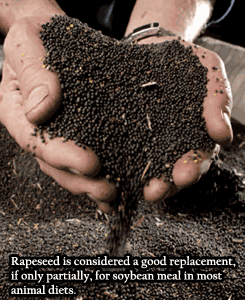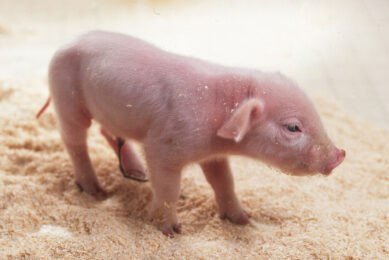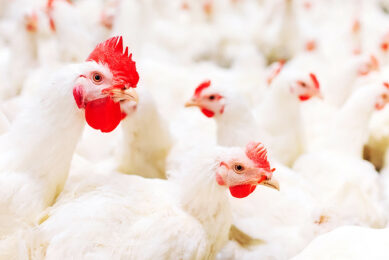Rapeseed meal in animal diets

In the past few years, rapeseed cultivation has increased dramatically in the European Union, especially in countries like Germany, where renewable sources of energy are becoming important to national interests. Rapeseed oil has been proved to be one of the best sources for biodiesel, and an increasing amount of rapeseed meal has raised the level of interest among nutritionists and producers alike. In general, rapeseed is considered a good replacement, if only partially, for soybean meal in most animal diets.
By Dr. Ioannis Mavromichalis, Ariston Nutrition, Madrid, Spain
Rapeseed (Brassica napus and Brassica campestris), which is a member of the same family as mustard, cabbage, and turnips, is a major oil-yielding crop, ranking third after soybeans and palm. It is cultivated in countries with colder climates that are usually unsuitable for growing soybeans. Major producing regions include the European Union, Canada and USA, China, India and Australia.
Rapeseeds are first crushed to remove the oil, yielding rapeseed cake as the first by-product. In most cases today, the cake is further processed through solvent extraction, yielding rapeseed meal as the final product (Table 1). On average, rapeseed meal contains on an as-fed basis (90% dry matter) 36-38% crude protein, 10-12% crude fibre, 1-2% lipids (oil), 6-8% ash, less than 1% calcium, and 1.2% total phosphorus. Composition varies widely depending on factors such as origin, growing conditions, the manufacturing process and degree of oil extraction.
Anti-nutritional factors
Regular varieties of rapeseed contain high levels of anti-nutritional factors that cause problems in all production animals. These factors include glucosinolates (goitrogenic), erucic acid (toxic), tannins, sinapine, phytic acid, and mucilage. The most important from the point of view of animal production are the glucosinolates that reduce feed acceptance due to their ‘hot’ and pungent taste (similar to that in mustard and horseradish). Erucic acid (a fatty acid) is an issue for humans as it is removed by oil extraction, although rapeseed cake contains a relatively high amount of residual oil. Since these anti-nutritional factors are not greatly affected by heat treatment, it is only through plant breeding that their presence has been significantly reduced in modern varieties. Rapeseed varieties low in glucosinolates or erucic acid are often referred to as ‘0-rapeseed’, and those low in both glucosinolates and erucic acid as ‘00-rapeseed’. The latter is the most common variety used today, worldwide, in oil production for human consumption.
The levels of glucosinolates should be controlled by frequent chemical analysis and should be part of the buying contract. A less accurate yet rapid test involves the tasting of rapeseed meal: if the meal is ‘hot’ like spicy mustard then it is rather high in glucosinolates. In addition, 00-rapeseed varieties produce a meal that is lighter in colour (tan) compared to that produced by normal varieties (toasted)- this has to do with plant breeding since 00-rapeseed varieties have lighter coloured seeds.
It should be noted here that many varieties cultivated with the purpose of producing oil for biodiesel are not of the ‘double-zero’ quality. Thus, it is imperative to know the variety of origin before buying and using rapeseed meal for animal diets.
Canola worldwide standard
Canola stands for ‘CANadian Oilseed, Low-Acid’ and it is a variety of 00-rapeseed (Brassica campestris) developed in Canada in the early 1970s. It is characterised by low levels of glucosinolates and erucic acid, making it suitable for human (oil) and animal (meal) consumption. Today, the term ‘canola’ is used worldwide to indicate all 00-rapeseed varieties, regardless of their origin.
Feeding normal rapeseed meal
If rapeseed with normal (higher) levels of glucosinolates and erucic acid is to be fed to livestock then, naturally, usage must be limited to avoid reduced performance and ensure animal health. In general, as in most cases, ruminants are less susceptible to anti-nutritional factors than monogastric animals. Thus, dairy cattle should be fed no more than 2-4 kg of rapeseed meal per head per day. In beef cattle, rapeseed meal should not exceed one quarter of the total concentrate fraction of their ration. In sheep and goats, rapeseed should not exceed 20% of their total ration. In pigs, rapeseed should be used only in diets for finishing pigs and gestating sows (less than 10% of total diet). Young poultry should receive no more than 2-3% of their diet as rapeseed meal, whereas up to 5% may be fed in older birds. In general, caution is the key word when using rapeseed meal for the first time or rapeseed meal from a new source. It is always best to start with very low inclusion levels and gradually increase them until an optimal balance between performance and cost of production is achieved. Here, the advice of a qualified nutritionist is strongly recommended.
Feeding canola-quality rapeseed meal
Rapeseed meal from ‘double-zero’ varieties (canola) can be used more freely than normal rapeseed meal. In such cases, it is best to first limit inclusion of canola to no more than 25-50% of soybean levels. In reality, this has been proven often to be the best-case scenario for most species. Although there are several research reports showing that canola has completely replaced soybean meal successfully, this should be avoided in practice unless the quality of canola is assured and diets are balanced and double-checked by a qualified nutritionist. Under most commercial conditions, in ruminant diets canola meal can be used as the sole protein source (given the precautions indicated above). In pigs, canola may be safely used to no more than 5-10% for young pigs and to 15-20% for older pigs. In chicks, even low levels (5%) may occasionally suppress growth, so it is best not used there at all. In older birds (including broilers), it can be used to 5-8% without problems. For horses, it is best to limit daily intake to less than 0.1% of live weight.
Glucosinolates as the guiding factor
Some nutritionists with access to data on actual levels of glucosinolates in given batches of rapeseed meal prefer to use this figure as their guide when determining inclusion levels. This method ensures maximal inclusion levels are used and hence maximal feed cost savings (in most cases) are secured. Most laboratory reports include data on gluconapin (major glucosinolate in rapeseed). Gluconapin is found in levels ranging from up to 0.25% in rapeseeds down to 0.05% in canola-quality rapeseed meal. Examples of ‘rationing’ rapeseed meal based on gluconapin are illustrated below.
Ruminants
Maximal daily intake should not exceed 0.1 gram per kilogram of live weight. Thus, a dairy cow with a live weight of 600 kg should not consume more than 6 grams of gluconapin per day. This can easily be transferred into the ration formulation software as a limiting factor.
Pigs
Maximal daily intake should not exceed 0.02 grams per kilogram of live weight. Thus, a fattening pig at a live weight of 100 kg should not consume more than 0.2 grams of gluconapin per day.
Brown eggs and fishy odour
Hens with the Rhode Island genes producing brown-shelled eggs should never be given diets including rapeseed meal or any other ingredient containing sinapine. In all birds, sinapine is converted in the cecum to trimethylamine, which is subsequently absorbed, deaminated and then excreted. Hens with the Rhode Island genes lack the ability to deaminate this compound, which builds up in the blood, and it is transferred to the egg. Like most amines, trimethylamine imparts a fishy odour that consumers strongly object to.
Avoid high sulphur content
Rapeseed and canola meals contain substantial levels of sulphur which, in contrast to soybean, is not part of sulphur amino acids (methionine and cystine). Rapeseed and canola meals contain about 1.5% sulphur whereas soybean meal contains less than 0.5%. This high sulphur content often creates several problems. In broilers, it has been associated with leg problems. In layers, it has been associated with reduced calcium absorption. In piglets, it might lead to secretory diarrhoea and, of course, in breeding pigs, it might create problems with calcium absorption leading to reduced reproductive performance. It is currently believed that the sulphur contribution of rapeseed meal should be accounted for in the anion-cation balance of the complete ration to avoid such problems, especially when high levels are used or the diet (or the water) is already rich in sulphur.
Rapeseed and peas
Rapeseed meal is low in lysine and rich in methionine-cystine. It is also low in energy (15-20% less than in soybean meal). In contrast, peas, which are grown in areas similar to those used for growing rapeseed, are rich in lysine and energy and low in methionine-cystine. Thus, the combination of rapeseed meal and peas is considered ideal, especially for pig diets, and an ideal combination of crops for cultivation purposes











